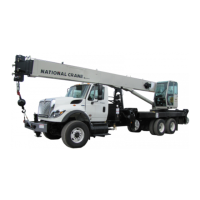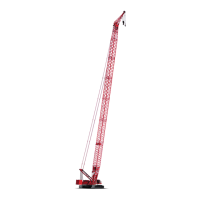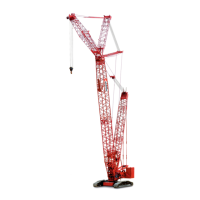INTRODUCTION 14000 SERVICE MANUAL
1-62
Published 09-05-14, Control # 226-02
LOWER ACCESSORY SYSTEM
The lower accessory valve system includes crawler pin
pusher cylinders and carbody jack cylinders that are enabled
by return-to-center hand levers. Output flow from the lower
accessory system passes through control levers and back to
tank when all of the levers are centered.
When a control lever is manually enabled, flow to the
carbody enable pressure sender is blocked by the control
lever. System pressure bleeds out through orifice and
system pressure drops, sending an input signal to the
node 1 controller. Node 4 controller then sends a 24 volt
variable output to drum 1 pump EDC to stroke the pump in
the low-pressure side direction. A level is mounted on
carbody near manual control levers.
Carbody Jacking System
The two-stage telescopic type jacking cylinders are mounted
on each corner of carbody. Jacking cylinder operation is
controlled with hydraulic valve handles on front of carbody
and computer programming. Operation of all four jacking
cylinders is the same.
Each carbody jacking cylinder has a counterbalance valve at
cylinder ports. Counterbalance valves ensure smooth control
when raising or lowering the carbody/rotating bed.
Counterbalance valves lock jacking cylinders in place if there
is a hydraulic line breakage or accidental operation of control
valve when the crane's power is shut down. Also,
counterbalance valves provide relief protection for cylinders
and shields them from mechanical overloading.
When a jacking cylinder control valve handle is not enabled,
it assumes a neutral position and hydraulic fluid passage to
jacking cylinder is blocked. In neutral, both valve section
cylinder ports are connected to tank. This prevents in line
pressure from opening counterbalance valve, holding load in
position by the counterbalance valve.
Carbody Jacking Cylinder Raise
See Figure 1-34.
Any or all jacking cylinders can be operated at the same
time, but jacking will not be level. The following description of
operation is for both right side jacking cylinders.
Move jacking levers back to raise position to raise jacking
cylinder. This shifts selected lower accessory valves to block
charge pressure to carbody pressure sender. System
pressure bleeds out through orifice and system pressure
drops, sending an input signal to the node 1 controller.
Node 4 controller sends a variable 28 output voltage to drum
1 pump EDC that tilts pump swashplate to stroke pump in the
low-pressure side direction. Hydraulic fluid flows through
upper accessory system valve to lower accessory valve
where system pressure approximately 3,100 psi (215 bar).
Hydraulic fluid exits valve section of lower accessory valve
into counterbalance valve. Hydraulic fluid then enters piston
end of jacking cylinders, extending cylinders to raise the right
side of carbody.
Hydraulic fluid rod end of the jacking cylinders is blocked by
free-flow check valve section of counterbalance valve and
flows through flow restraining section that has a relief setting
of 3,500 psi (240 bar).
Counterbalance valve acts as a deceleration control and
functions with a 3:1 pilot ratio of relief pressure. This permits
valve to open when the pressure in rod end of cylinders is
approximately 1175 psi (81 bar). Restraining section of
counterbalance valves open, controlling the fluid out of
jacking cylinders. Hydraulic fluid then flows through free-flow
check valve section of flow control valve before entering
lower accessory valve. Hydraulic fluid leaving lower
accessory valve returns to tank.
Move selected levers back to neutral position when desired
height is reached. When system pressure beyond lower
accessory valve increases, an input signal to the node 1
controller. Node 4 controller sends a zero output voltage to
drum 1 pump that returns pump swashplate to neutral and
de-strokes the pump.
WARNING
Collapsing Hazard
Keep carbody as level as possible while jacking.
Operating jacking cylinder with rotating bed more than 3°
out of level can cause structural damage to jacking
cylinders and possible collapse of rotating bed.

